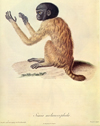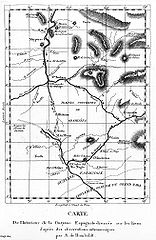Meeting 12 • 14 February 2013 • Thursday
|
Version: |
|
pictures of the week
|
thought-bite of the week: "Rivers have only a slight, often imperceptible fall.… We stopped by the mouth of the Caño de la Triguera… to measure the speed of the current, which was 2.56 feet an hour."(Humboldt, "Personal Narrative", from Jaguars and Electric Eels, ed. & trans. Wilson, p. 49, 67) |
|
mini-text of the week (start): "In this interior of a new continent you get used to seeing man as not essential to the natural order…"Humboldt, "Personal Narrative", from Jaguars and Electric Eels, ed. & trans. Wilson, pp. 99 (read more) |
|
√ |
1) Measuring the heights of mountains and such: What was the alternative to the barometer in Humboldt's time, if you couldn't put someone down in the mountain directly under its peak and level with the observer on the plain at the base of the mountain? (hint: the conceptual hero of this course is probably the right triangle), 2) How flat Kansas is: how "flat" (="even" = unvarying from the surface of a sphere) is the Earth? How does that relate to (1) above - measuring mountains? What does "The World Is Flat" refer to in recent serious political & economic discussion? (hint: Thomas Friedman) 3) Words for "science", "scientist", and the specific sciences: "physico-mathematicall experimentall" (Bryson, book about Royal Society). Sources of information about: the history of words – the Oxford English Dictionary (OED); and the state of knowledge "back then" (=1800) from its own perspective – The Encyclopédie (1751-1772) of Diderot & d'Alembert (Wikipedia; • complete French text in e-facsimile • PSU has it as ink-on-paper facsimile) |
|
+ |
(05') This week's mini-text: Humboldt's observation that climate and vegetation zones on a mountain near the equator replicate the distribution of climate and vegetation zones from the Equator to the Poles: So what's the big deal – was he the first to notice that? How does this set the stage for Darwin? Another meaning of "1 vs. 99%": Thomas Edison's definition of "genius". Humboldt's enormous contribution to climate science and the origins of sustainabile environmentalism: the Chimborazo research and the iconic diagram (this link is to a SIMPLIFIED version) – a brief look, followed by more discussion in later meetings. This is one of the very most important knowledge points of the course. If necessary, read and re-read Helferich, pp. 223-233 to glimpse both the heroic nature of the physical accomplishment and the immense importance of the yield to science in general and sustainable environmentalism in particular. That will give you some essential facts and concepts. But the rest of the reading and discussion in the course is necessary to add at least some the depth and breadth that are necessary to relate Humboldt and Chimborazo to the larger context. Special points: natural history collections; rarity of travel; topographic mapping (Wikipedia; Geosciences, Idaho State U) |
|
+ |
(20') What happens when you read Darwin? Data, amazing powers of observation, structure of argument, presentation of argument ("rhetoric") - appeals to common sense, shared experience, admission of uncertainty; God and Creation in The Origin of Species. Similar reading experiences: Geneva Convention, Federalist Papers, maybe Hobbes/Locke/ Smith, probably not Newton. This is a preview of the topic: So what can the educated citizen read while we wait to see what today's classics will be? (periodical press; local, quotidien; long-term knowledge). How do educated citizens become capable writers? Small groups: Where do you get your citizen information, and how do you check it out? |
| √ |
(15') More about writing assignment #3 and how it relates to later parts of this course. 1) How many have talked this over with: friends? siblings? parents? former teachers? current teachers (other courses)? employers? Anindita (individually)? me (individually)? 2) More about educational standards and their parts in the course, and how that relates to the individual and group projects: a) Standards are regarded as a necessary part of creating curricula and competent learning activities in SCHOOL but NOT necessarily COLLEGE!) – so it may benefit you to learn about them as you evaluate your own education, especially now that you are in college. b) Educating the young(ish) learner about sustainable environmentalism, as you will explore with your projects, requires systematic learning mapped onto standards. Here are examples: Lyon Arboretum and Hawaii school standards • Hawaii STEM Intercommunity Portal • Enchanted Learning - but one of many sources of learning activities, especially for younger learners. Here's their "Explorers" page about Humboldt. Here's their section about "astronomy:Earth", with activities that could be inspiration for learning activities for Humboldt-named schools. Here is "ThirteenEd Online", about lesson plans (example: math). And here's a blog article, from Scientific American, that attacks state science education standards, including Oregon's, as "'mediocre to awful." |
|
+ |
(10') Writing assignment 04: Presentation of a Humboldt-named or -related species starts officially today and is due in two weeks (Thursday, February 28). Avoid the Humboldt Penguin and the Humboldt Squid, since so many people make them their easy choice and we've had too much of those "Bambi" creatures already and not enough attention to other Humboldt-named species, especially plants. If you go with the penguin and the squid, your project will be judged by particularly strict standards. But the penguin and squid can be used in group projects. |
|
+ |
(05') Second look at ideas for group projects: which skills do they need / which skills map onto which ideas? Link to the group project specifications. |
|
+ |
(5') Announcements, Checkups & Previews: 1) midterm (outside class) is due today; 2) Humboldt-named species – will be chosen in mentor workshops; 3) Have you chosen and started reading the book for your review? (circulate signup list for people who need help) 4) more about the iconic graphic of Chimborazo; 5) apps Humboldt would have liked; 6) grants, jobs, résumé lines through PSU Institute for Sustainable Solutions; grants and conferences elsewhere Upcoming: 1) presentation about society back then (and any time before 1800 or so), to help understand how H related to people of other classes / races (teaser: When was it that someone's ears first popped with a change in altitude?); 2) advice about "educated citizen" reading, with a short sample One focus of "interpreting the past" to the present during the rest of the course: land and water allocation and use in the |

